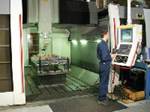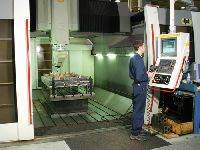Wind Power Industry Opportunities Blowing Our Way
Moldmakers wishing to tap into this growing market should do their research and reach out to both wind power industry experts to learn about windmills and cutting tool suppliers to learn what it takes to enter this field.
Opportunity is blowing in the wind for many auto parts makers. With automakers slumping, many auto parts makers and suppliers have to look elsewhere for work. Currently more than 500 Michigan moldmakers and manufacturers are doing some kind of wind energy work and in many cases are still auto parts suppliers. The shift to the wind industry came quite naturally. Many of the parts are extremely large; however the processes and materials are very similar to what these manufacturers are accustomed to. The transition for many was not an easy decision. How do you leave Ford or GM—who are such powerful customers? Many suppliers may struggle with this.
This industry has a lot of opportunity to bring this work over from Europe. The wind manufacturers are having difficulty sourcing their components from the original manufacturers since the demand is so high—and many of those are based in Europe. Many European companies are building factories in the U.S. and are contracting with local suppliers, as it is costly to transport large components overseas. So there is a huge opportunity if manufacturers are willing.
Wind mill installations are increasing 15 to 25 percent per year and are expected to accelerate—especially states such as Texas and California. These states are windy, have sparsely populated land for wind farms and a friendly regulatory environment for developers. Texas also is using its abandoned oil fields as wind farms. With that, many tons of material such as steel and cast iron must be machined.
Seize the Opportunity
The automotive industry is a tough industry and the wind industry will have its challenges too. Look to join or affiliate yourself with associations and venture to some seminars and exhibitions to network your company. Be patient, it is not going to happen overnight. Do your homework. Find out who the players are and what their expectations are. Go online and research organizations like the Great Lakes Wind Network (GLWN; glwn.org) and American Wind Energy Association (AWEA; awea.org). Examine the components of a windmill and see what your shop can accommodate. Windmills have hundreds of parts, like connecting rings, hubs, main shafts, planetary carriers and a main frame.
Does your shop have the experience, the machines/equipment and the square footage? Depending on what you choose to machine, having a large boring mill, large machining center (50 taper), gantry mill or a VTL is recommended. Many of these parts are very large; a bearing housing can weigh as much as 5,000 lbs and a hub can be over 12 feet in diameter.
Another extremely important requirement is to be able to machine high quality (void of burrs and under a Ra 32 finish) and to maintain tolerances (depending on the components, tolerances can be as tight as 0.0005"). Tolerances and quality are important with windmills because the components are installed at the top of a tower, which can be as high as 200 feet. Replacing parts can be very expensive and difficult. Also make sure you are familiar with European standards, such as DIN (en-standard.eu/), since many of these windmill companies originated in Europe. You also should be ISO registered—having the proper systems and auditing procedures in place.
Look closely at your own competencies, and then match them to the components on the windmill. For example, a connecting ring can be 12 feet in diameter, so you would need a VTL capable of handling such a component and a large enough hoist to accommodate it. Many parts—such as platforms—are simply faced milled. The materials are similar to what shops are used to: 4140, 4340, GCI and NCI to name a few. The machines that many of the auto suppliers have are many times capable of handling these parts. Large boring mills, VTLs, machining centers, gantry and planer mills are the ideal machines to produce these large parts.
Cutting to the Chase
The wind power industry is quickly becoming competitive. Be sure you are using the most advanced cutting edge tools and techniques that can help you be more productive and get much better tool life—which in the long run will save you time and money. Through the use of proper tools and techniques, the cutting data can be increased to achieve an optimum solution for a particular task.
You do not have to worry about retooling your entire shop. Have your local cutting tooling supplier work with you and discuss your tooling options. A tooling specialist should sit down with you to review what components can be used for specific operations. Many shops will find they already have the right tools (e.g. face mills, insert drills, SC drills, back face mills, shoulder mills, etc.), they may just have to change grades or geometries. There also are specific tools designed for certain materials and operations. You wouldn’t use a button cutter if you need a good surface finish on a face mill operation.
An Energetic Future
Windmills are fantastic instruments—producing energy from an endless source without waste. The U.S. currently gets less than one percent of its energy from wind power and many federal officials are pushing for 20 percent by 2030. Successful windmill producers around the world face a rapid increase in demand and are constantly looking for ways to produce more components faster. Why not be a part of this growing industry?
For more information from call (201) 794-5000, e-mail lianne.mills@sandvik.com, visit coromant.sandvik.com/us or visit moldmakingtechnology.com.
Related Content
The Benefits of Hand Scraping
Accuracy and flatness are two benefits of hand scraping that help improve machine loop stiffness, workpiece surface finish and component geometry.
Read MoreForces and Calculations Are Key to Sizing Core Pull Hydraulic Cylinders
To select the correct cylinder, consider both set and pull stroke positions and then calculate forces.
Read MoreLaser Welding Versus Micro Welding
The latest battle in finely detailed restoration/repair of mold materials.
Read MoreMachining Center Spindles: What You Need to Know
Why and how to research spindle technology before purchasing a machining center.
Read MoreRead Next
Reaching Out to a Different Market to Survive Tough Times
This mold manufacturer has reassessed its market base and began dabbling in the energy industry based on its experience with CNC machining—making it a natural transition.
Read MoreHow to Use Strategic Planning Tools, Data to Manage the Human Side of Business
Q&A with Marion Wells, MMT EAB member and founder of Human Asset Management.
Read MoreAre You a Moldmaker Considering 3D Printing? Consider the 3D Printing Workshop at NPE2024
Presentations will cover 3D printing for mold tooling, material innovation, product development, bridge production and full-scale, high-volume additive manufacturing.
Read More









.jpg;maxWidth=300;quality=90)
_300x250 1.png;maxWidth=300;quality=90)














